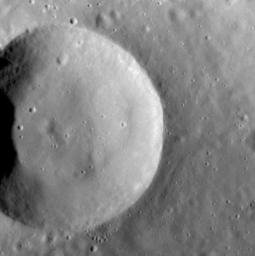
|
Simply Cratering
- Click the image above for a larger view
- Full-Res JPEG (509 x 512) (25.1 kB)
- Full-Res TIFF (509 x 512) (261.1 kB)
Caption:
Simple craters adorn Mercury's surface. This unnamed example lies in the northern volcanic plains , and likely post-dates most of the volcanism in the region. Its raised rim is still largely preserved, suggesting that it is relatively young -- by Mercury's standards: it's probably still many millions of years old! Its interior is slightly raised, the result of deformation by a small wrinkle ridge located just to its east.
This image was acquired as a high-resolution targeted observation. Targeted observations are images of a small area on Mercury's surface at resolutions much higher than the 200-meter/pixel morphology base map. It is not possible to cover all of Mercury's surface at this high resolution, but typically several areas of high scientific interest are imaged in this mode each week.
Date acquired:
September 02, 2013
Image Mission Elapsed Time (MET):
20407784
Image ID:
4744802
Instrument:
Narrow Angle Camera (NAC) of the Mercury Dual Imaging System (MDIS)
Center Latitude:
63.4°
Center Longitude:
336.0° E
Resolution:
23.9 meters/pixel
Scale:
This crater is 9.4 km (5.8 mi.) in diameter
Incidence Angle:
63.51°
Emission Angle:
9.49°
Phase Angle:
54.02°
North is to the right of the image.
Background Info:
The MESSENGER spacecraft is the first ever to orbit the planet Mercury, and the spacecraft's seven scientific instruments and radio science investigation are unraveling the history and evolution of the Solar System's innermost planet. MESSENGER acquired over 150,000 images and extensive other data sets. MESSENGER is capable of continuing orbital operations until early 2015.
For information regarding the use of images, see the MESSENGER image use policy .
Cataloging Keywords:
| Name | Value | Additional Values |
|---|---|---|
| Target | Mercury | |
| System | ||
| Target Type | Planet | |
| Mission | MESSENGER | |
| Instrument Host | MESSENGER | |
| Host Type | Orbiter | |
| Instrument | Mercury Dual Imaging System (MDIS) | |
| Detector | Narrow Angle Camera (NAC) | |
| Extra Keywords | Crater, Grayscale, Map, Radio, Volcano | |
| Acquisition Date | ||
| Release Date | 2013-11-27 | |
| Date in Caption | 2013-09-02 | |
| Image Credit | NASA/Johns Hopkins University Applied Physics Laboratory/Carnegie Institution of Washington | |
| Source | photojournal.jpl.nasa.gov/catalog/PIA17742 | |
| Identifier | PIA17742 | |
